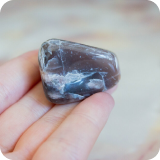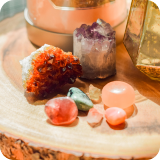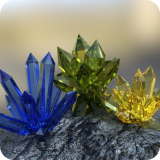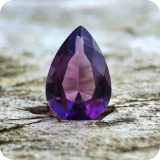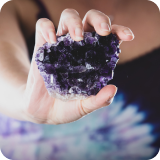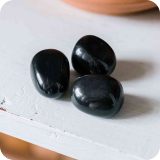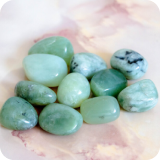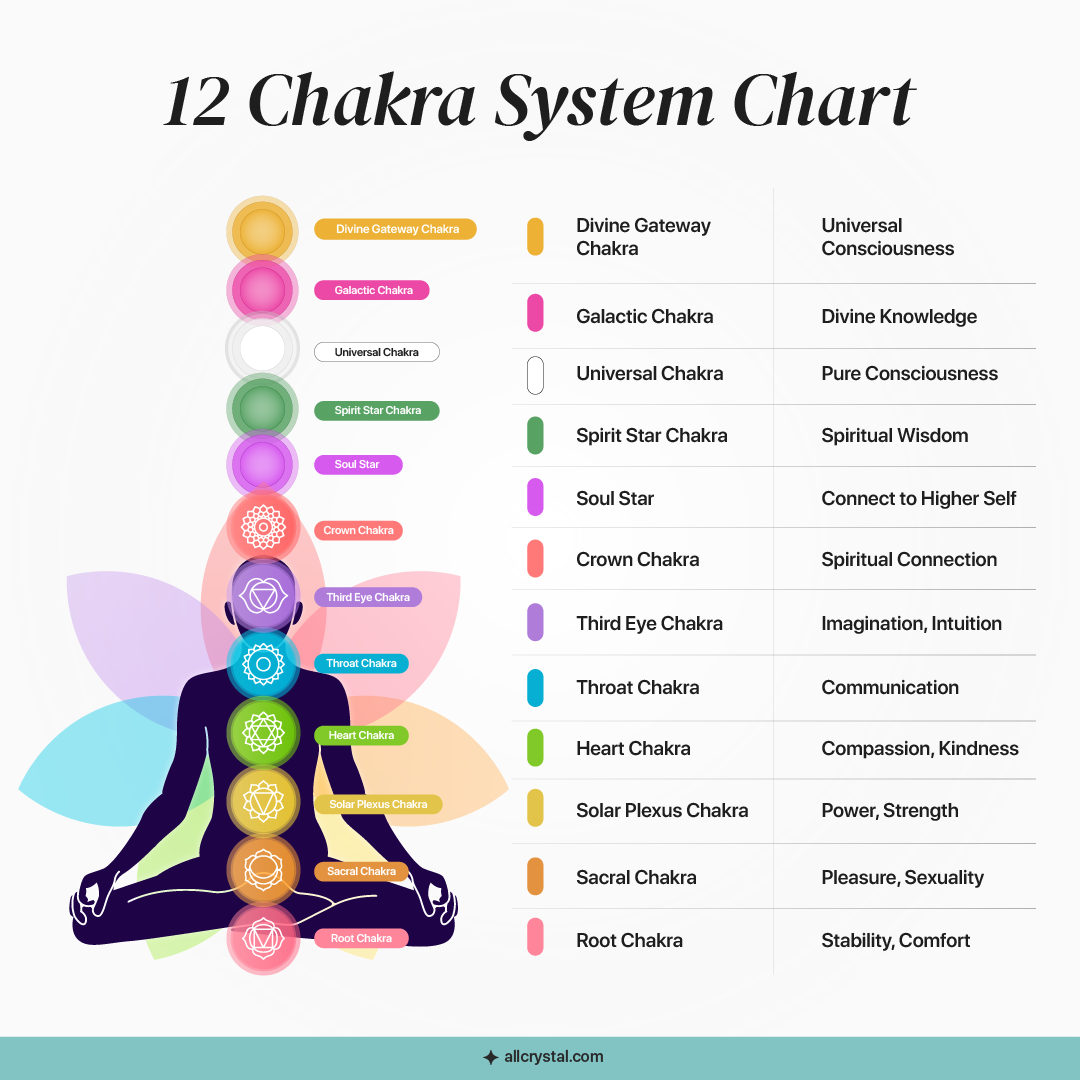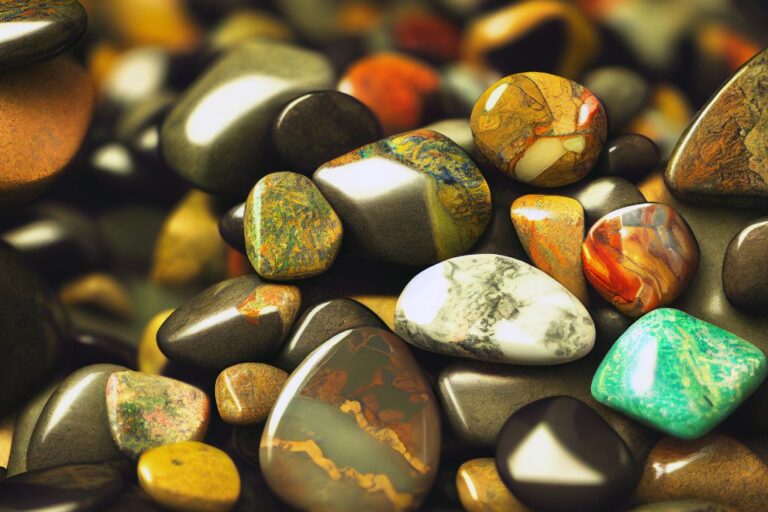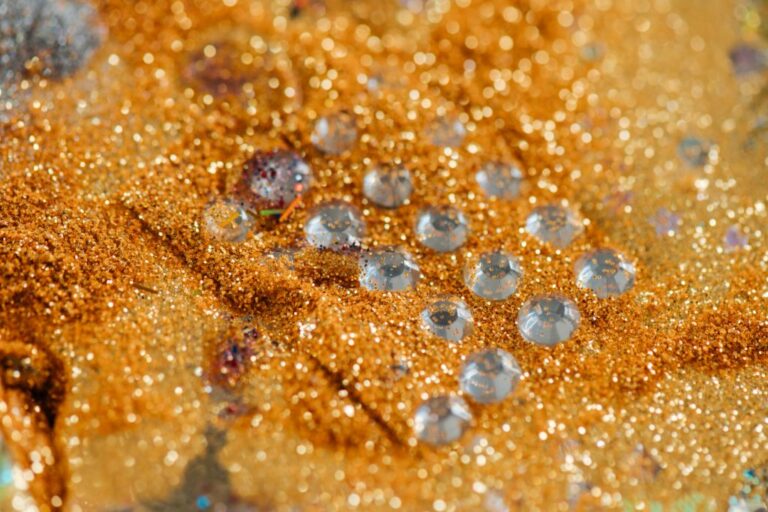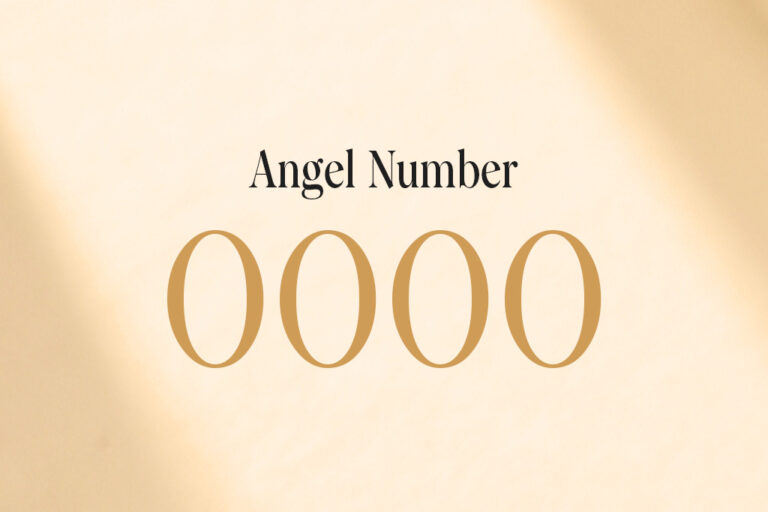Binghamite
(bing-ham-ite)What is Binghamite?
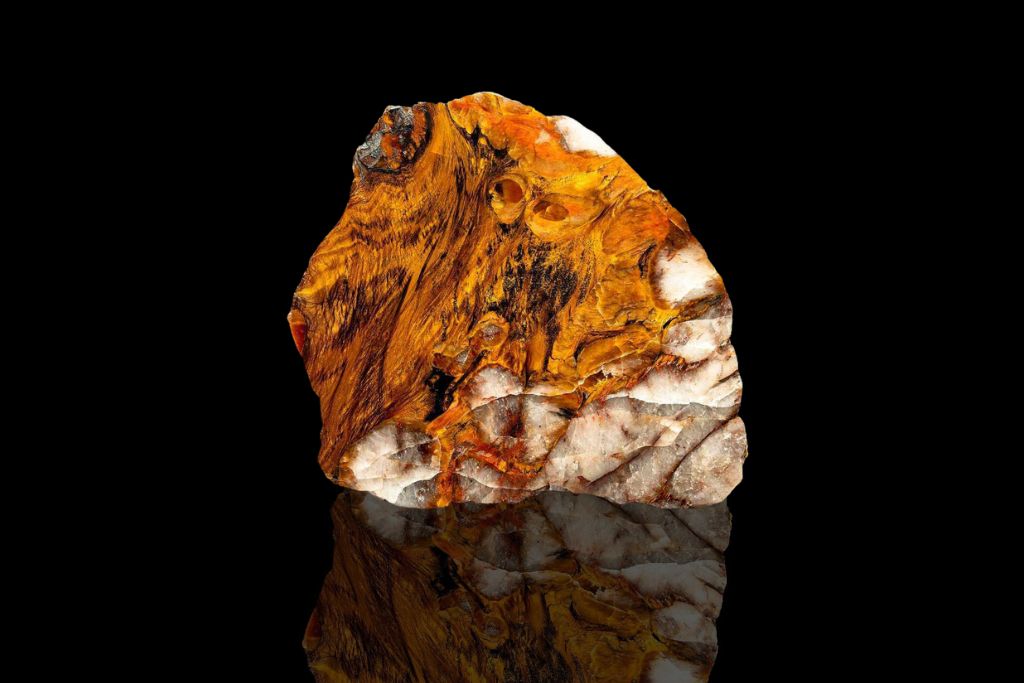
The intriguing Binghamite is well recognized for its vivid colors, which can vary from yellow to red. Its texture is a fascinating mix of fibrous and crystalline elements, creating a unique pattern that makes it highly sought after for slabs and cabochons.
At its core, Binghamite is a variety of Quartz, specifically a type of Chalcedony. It primarily comprises fibrous materials, like amphiboles, intermingled with fine to coarse-grained crystalline Quartz. A complex mixture of Quartz, Siderite, iron, and manganese oxides, like Hematite and Goethite, results from these changes.
The crystal was first described in 1936 by Bill Bingham, co-founder and first president of the Minnesota Mineral Club. It hails from the Cuyuna North Iron Range mines in Crow Wing County, Minnesota. Binghamite is closely related to Minnesota Silkstone and Minnesota Tiger’s Eye; all three can be found in the same specimen.
For crystal enthusiasts and collectors, Binghamite is a prized possession. Its unique composition and vibrant colors make it a standout among other crystals. The crystal is often used in lapidary work, and its fibrous nature adds to its allure.
Did you know that Binghamite is sometimes called “American Tiger’s Eye?” It’s not just a pretty face; this crystal has an interesting mythological background. Some believe it possesses healing properties, although this is more of folklore than scientific fact.
Beyond its physical and historical attributes, Binghamite carries a certain mystique that has captivated the hearts of many. This crystal’s bright colors, complex composition, and folklore-infused reputation draw people in.
It’s as if Binghamite whispers a pearl of ancient wisdom. It invites you to explore its surface beauty and its untapped potential for spiritual and emotional growth. This makes it more than just a collector’s item; it’s a gateway to a richer, more balanced life.
Binghamite Healing Properties & Benefits
Health and Balance
- Binghamite is believed to align your body’s energy, promoting overall well-being.
- Place the crystal on your Solar Plexus Chakra to harness this and meditate for 10 minutes.
Anger Management
- The crystal’s grounding properties can help diffuse anger and emotional spikes.
- Hold the stone in your hand while taking deep breaths to activate its calming effects.
Deep Healing
- Binghamite is said to accelerate the body’s natural healing processes.
- For this, keep the crystal close to you during sleep or meditation.
Intelligence and Versatility
- The stone is thought to sharpen your mental faculties and adaptability.
- Place it on your study desk and focus on it for a few minutes before tackling complex tasks.
Sound Sleep
- Binghamite is believed to regulate your circadian rhythm for better sleep.
- Keep it under your pillow or on your nightstand, and set an intention for a restful sleep before dozing off.
Binghamite Spiritual Properties & Benefits
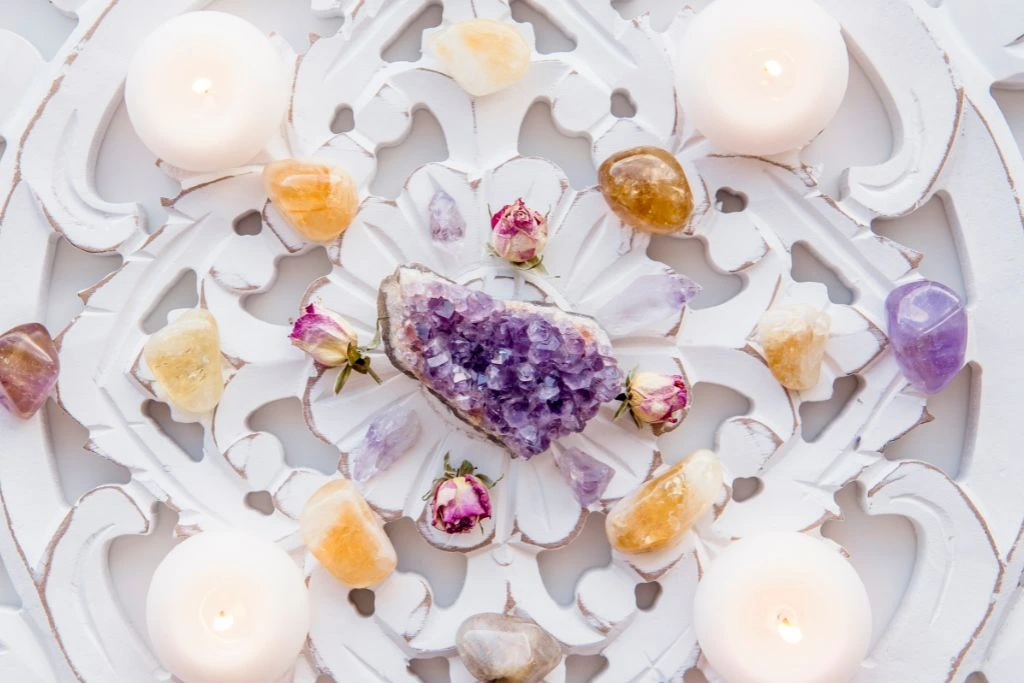
Aura Cleansing
- Binghamite is said to purify your aura, clearing out negative energies.
- To cleanse your aura, circle the crystal around your body while focusing on positive thoughts.
Dreamwork
- The crystal is believed to enhance dream recall and lucidity.
- Place it under your pillow and set an intention for vivid, meaningful dreams before sleep.
Luck and Wealth
- Binghamite is thought to attract good fortune and financial prosperity.
- Keep the crystal in your wallet or a money jar to activate its wealth-attracting properties.
Manifestation
- The stone is said to amplify your intentions, aiding in the manifestation process.
- Hold the crystal while visualizing your goals, then keep it close to remind you what you manifest.
Spiritual Healing
- Binghamite is believed to heal emotional wounds, helping you move forward spiritually.
- Meditate with the stone on your Heart Chakra to activate its spiritual healing properties.
Side Effects of Binghamite
- Detachment: Binghamite can sometimes make you feel disconnected from your surroundings. To counter this, try grounding exercises, like walking barefoot on grass.
- Hyperactivity: The stone’s energizing properties might make you too jumpy. Calm down by pairing it with a grounding stone, like Hematite.
- Burnout: Overuse can lead to emotional and physical exhaustion. Take breaks from the crystal and hydrate well to recharge.
Binghamite Meaning: What Does Binghamite Symbolize?

Binghamite symbolizes “grounding, intuition, and emotional balance.”
The crystal gets its name from Bill Bingham, the co-founder and first president of the Minnesota Mineral Club. He was the first to describe this unique material back in 1936. The name carries a legacy, connecting the crystal to its origins in the Cuyuna North Iron Range in Crow Wing County, Minnesota.
Traditionally, Binghamite has been a stone of grounding and balance. It’s closely related to Minnesota Silkstone and Minnesota Tiger’s Eye. These stones share similarities, but each has its unique properties.
In folklore, it was often considered a healer’s stone, believed to possess the ability to align energies and promote well-being.
Today, people see Binghamite as more than just a pretty crystal. It’s often used in metaphysical practices for aura cleansing, dreamwork, and even attracting wealth. Some even refer to it as the “American Tiger’s Eye,” highlighting its versatility and wide range of uses.
You might come across Binghamite under different names like “Cuyunite,” named after its place of origin, the Cuyuna Range. Regardless of what you call it, the essence of the crystal remains the same—grounding, intuition, and a splash of good luck.
Types of Binghamite
- Red Binghamite: Vibrant and energizing, Red Binghamite is often used to boost confidence and courage.
- Yellow Binghamite: This sunny variety enhances creativity and is linked to the Solar Plexus Chakra.
- Brown Binghamite: Earthy and grounding, Brown Binghamite helps you stay focused and balanced.
- White Binghamite: Known for purity and clarity, White Binghamite is used in meditation and spiritual practices.
- Blue Binghamite: This rare shade enhances communication skills and emotional expression.
- Golden Binghamite: Often used to attract wealth and prosperity, it is a favorite among feng shui practitioners.
- Orange Binghamite: This variety is said to stimulate joy and social interactions.
- Black Silkstone: A close relative, Black Silkstone is used for protection and grounding.
- Multicolored Binghamite: Visual feast for the eyes, featuring a vibrant mix of colors such as reds, greens, blues, and yellows. This stone balances numerous chakras at once, harmonizing and aligning the body’s energy centers.
- Brecciated Binghamite: Known for its fragmented appearance, displaying various earthy tones like browns, tans, and grays. This variant helps people recover profound emotional traumas and trauma.
- Chatoyant Binghamite: Comes in numerous hues and has a mesmerizing cat’s eye look that shimmers. This type boosts intuition and insight, making it a useful tool for tapping into inner wisdom.
- Fibrous Binghamite: A variety known for its intricate fibrous structure. It ranges from pale green to deep forest green and may feature brown, yellow, or red streaks or veins.
- Binghamite with Epidote: When combined, the resulting stone is believed to amplify the energy of both minerals. Epidote provides dark green to black crystals or prismatic forms, whereas Binghamite keeps its red tints.
- Binghamite with Stilpnomelane: A combination known for its grounding and emotional balancing properties. Stilpnomelane is lustrous black to dark brown or grayish-black mineral flecks or streaks in Binghamite, which remains red.
- Binghamite with Minnesotaite: This blend combines the grounding properties of both minerals. Binghamite, with its orange hues, complements the brown to reddish-brown coloration of Minnesotaite.
- Binghamite with Quartz: Binghamite often has a brown or reddish-brown color, while Quartz is typically clear or white. This combination amplifies the energy of Binghamite, making it even more potent for healing and balance.
- Binghamite with Magnesio-Riebeckite: Known for its calming effects, especially when dealing with emotional turmoil. Magnesio-Riebeckite can be either a dark blue or black color, while Binghamite is typically a brownish color.
- Binghamite with Amphibole: This mix is often used for deep spiritual work and meditation. Brown Binghamite stands in contrast to the green, black, and brown of Amphibole minerals.
- Binghamite: Its earthy brown tint signifies its grounding nature, helping people connect with Earth forces and establish equilibrium.
- Binghamite with Goethite: Enhances the stone’s grounding effects and is often used for meditation. Binghamite is typically brown, while Goethite can range from brown to black.
- Binghamite with Blue Agate: Enhances communication and emotional expression. This blend is characterized by a rich mix of deep blues and greens, with streaks of white and sometimes brown.
- Binghamite with Manganese Oxide: Known for its detoxifying properties, making it popular for physical healing. Manganese oxide gives this variety vivid purples, browns, and blacks.
- Binghamite with Hematite: The combination produces a dark gray to black stone with red or silver streaks. It is often used for grounding and protection.
- Binghamite with Siderite: This blend showcases earthy tones, including shades of brown, rust, and sometimes hints of green. Enhances the grounding properties of Binghamite, making it a powerful tool for balance.
How to Cleanse Binghamite?
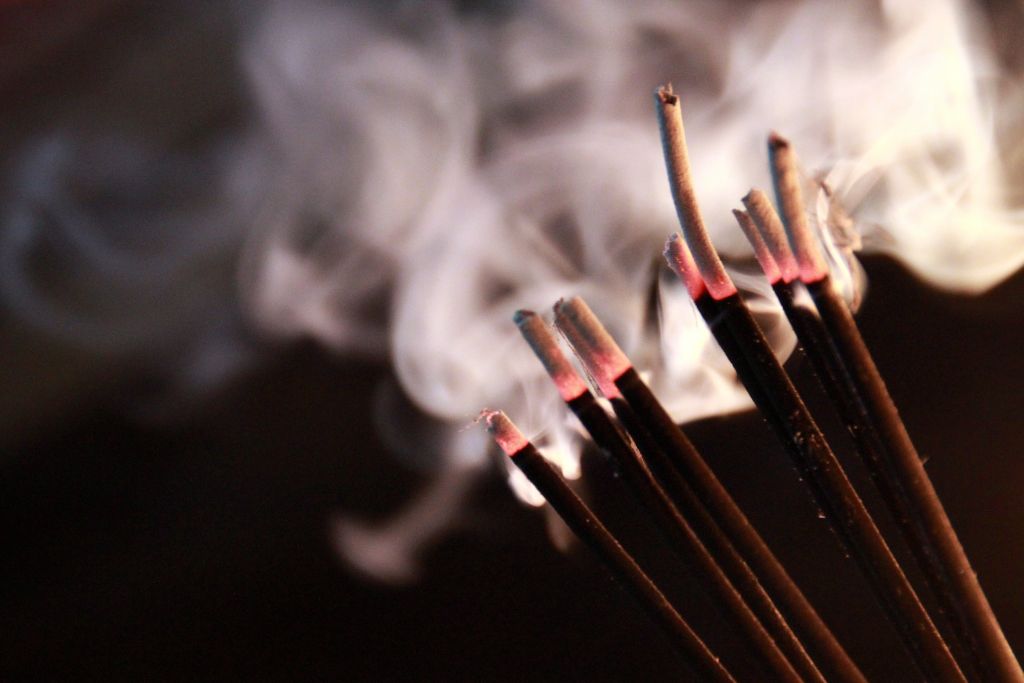
- Soil: Bury it in soil for 24 hours. Earth’s energy will naturally cleanse and recharge it.
- Meditation: Hold the crystal in your hand while meditating. Visualize a white light enveloping it to cleanse its energy.
- Incense: Pass it through the smoke of incense. This clears away any negative vibes clinging to the stone.
Questions and Answers
Yes, Binghamite is a natural variety of Quartz.
Yes, but it’s best to dry it immediately to maintain its quality.
Yes, handling Binghamite poses no harm.
No, prolonged exposure to sunlight can fade its vibrant colors.
When you rub Binghamite on a streak plate (a piece of unglazed porcelain), it will leave a white streak.
Interactions with Binghamite
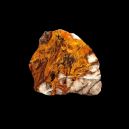
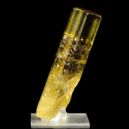
Binghamite vs. Heliodor
It is possible to wear Binghamite (Sun) and Heliodor (Jupiter) together without conflict. This crystal pairing enhances your confidence and brings optimism into your life.
| Crystal | Binghamite | Heliodor |
| Chakras | Root, Sacral, Solar Plexus, Heart, Throat, Third Eye, and Crown. | Solar Plexus and Crown. |
| Ruling Planet | Sun | Jupiter |
| Ruling Element | Fire | Fire |
| MOHS | 7 | 7.5 to 8. |

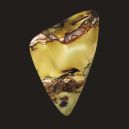
Binghamite vs. Arizona Tiger's Eye
Binghamite and Arizona Tiger’s Eye can be paired, as both are ruled by the Sun. Together, they enhance intuition and bring emotional balance.
| Crystal | Binghamite | Arizona Tiger’s Eye |
| Chakras | Root, Sacral, Solar Plexus, Heart, Throat, Third Eye, and Crown. | Root, Sacral, Solar Plexus, Heart, Throat, Third Eye, and Crown. |
| Ruling Planet | Sun | Sun and Mars. |
| Ruling Element | Fire | Fire and Earth. |
| MOHS | 7 | 7 |

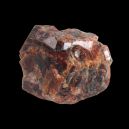
Binghamite vs. Pyrope Garnet
Binghamite and Pyrope Garnet are not a good match. Binghamite is ruled by the Sun, while Pyrope Garnet is ruled by Mars. The pairing could create conflicting energies.
| Crystal | Binghamite | Pyrope Garnet |
| Chakras | Root, Sacral, Solar Plexus, Heart, Throat, Third Eye, and Crown. | Root |
| Ruling Planet | Sun | Mars |
| Ruling Element | Fire | Earth and Fire. |
| MOHS | 7 | 7 to 7.5. |
Most viewed articles from Binghamite Crystal
